源码之Executor
1. 向RM申请资源
回到runDriver()方法,Driver线程执行,我们的WordCount程序中有new SparkContext(conf):  进入SparkContext类中,初始化的时候会自动执行代码块代码,其中有一段postStartHook()代码
进入SparkContext类中,初始化的时候会自动执行代码块代码,其中有一段postStartHook()代码  点击进去发现是抽象方法,查找实现为YarnClusterScheduler.scala的代码:
点击进去发现是抽象方法,查找实现为YarnClusterScheduler.scala的代码: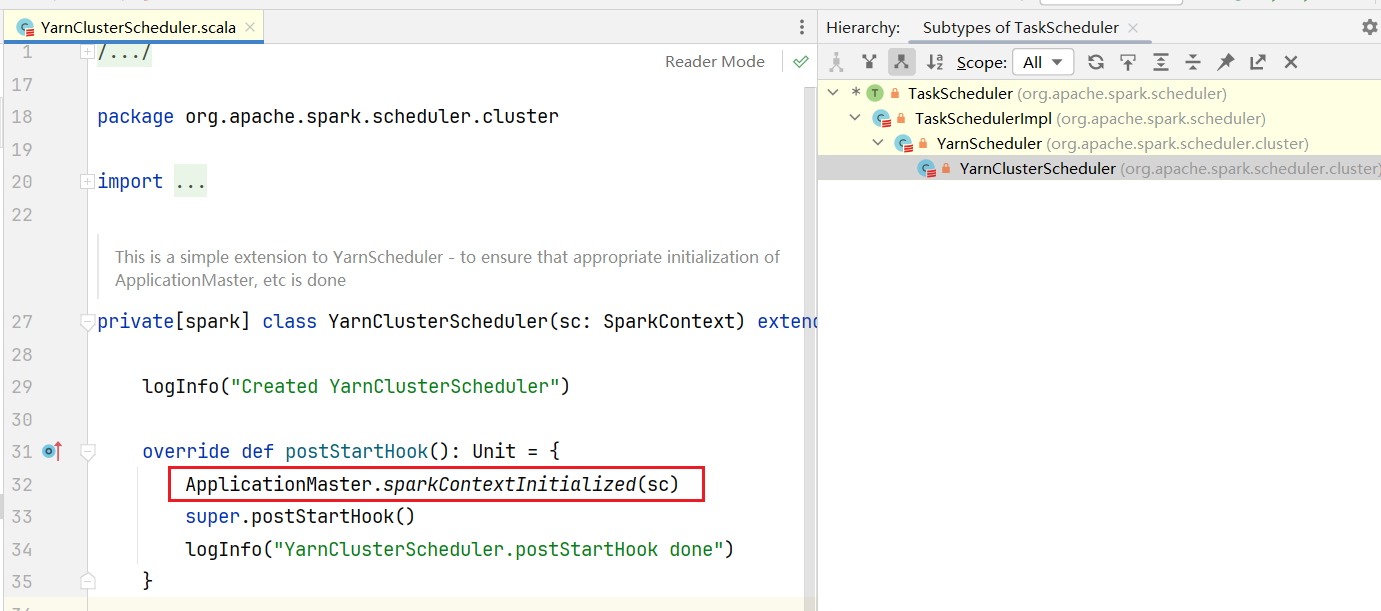 点击进入sparkContextInitialized()方法
点击进入sparkContextInitialized()方法  如果SparkContext初始化完毕后,继续执行runDriver后续代码:
如果SparkContext初始化完毕后,继续执行runDriver后续代码:
private def runDriver(): Unit = {
addAmIpFilter(None, System.getenv(ApplicationConstants.APPLICATION_WEB_PROXY_BASE_ENV))
userClassThread = startUserApplication()
val totalWaitTime = sparkConf.get(AM_MAX_WAIT_TIME)
try {
// 得到线程执行结果信息
val sc = ThreadUtils.awaitResult(sparkContextPromise.future,
Duration(totalWaitTime, TimeUnit.MILLISECONDS))
if (sc != null) {
// 获取远程通信信息
val rpcEnv = sc.env.rpcEnv
val userConf = sc.getConf
val host = userConf.get(DRIVER_HOST_ADDRESS)
val port = userConf.get(DRIVER_PORT)
// 向AM注册, 为了申请资源
registerAM(host, port, userConf, sc.ui.map(_.webUrl), appAttemptId)
val driverRef = rpcEnv.setupEndpointRef(
RpcAddress(host, port),
YarnSchedulerBackend.ENDPOINT_NAME)
// 创建资源分配器
createAllocator(driverRef, userConf, rpcEnv, appAttemptId, distCacheConf)
} else {
// Sanity check; should never happen in normal operation, since sc should only be null
// if the user app did not create a SparkContext.
throw new IllegalStateException("User did not initialize spark context!")
}
resumeDriver()
userClassThread.join()
} catch {
......
} finally {
resumeDriver()
}
}查询createAllocator()方法
private def createAllocator(
driverRef: RpcEndpointRef,
_sparkConf: SparkConf,
rpcEnv: RpcEnv,
appAttemptId: ApplicationAttemptId,
distCacheConf: SparkConf): Unit = {
......
val appId = appAttemptId.getApplicationId().toString()
val driverUrl = RpcEndpointAddress(driverRef.address.host, driverRef.address.port,
CoarseGrainedSchedulerBackend.ENDPOINT_NAME).toString
val localResources = prepareLocalResources(distCacheConf)
// 创建资源分配器
allocator = client.createAllocator(
yarnConf,
_sparkConf,
appAttemptId,
driverUrl,
driverRef,
securityMgr,
localResources)
......
// 获取ResouceManager上面可用分配的资源信息
allocator.allocateResources()
......
}2. 得到容器资源并自主选择
进入allocateResources()方法查看
def allocateResources(): Unit = synchronized {
updateResourceRequests()
val progressIndicator = 0.1f
// 得到RM的响应信息
val allocateResponse = amClient.allocate(progressIndicator)
// 获取可分配的容器信息列表
val allocatedContainers = allocateResponse.getAllocatedContainers()
allocatorNodeHealthTracker.setNumClusterNodes(allocateResponse.getNumClusterNodes)
if (isYarnExecutorDecommissionEnabled) {
handleNodesInDecommissioningState(allocateResponse)
}
// 如果可分配的容器还有,就会去处理容器
if (allocatedContainers.size > 0) {
logDebug(("Allocated containers: %d. Current executor count: %d. " +
"Launching executor count: %d. Cluster resources: %s.")
.format(
allocatedContainers.size,
getNumExecutorsRunning,
getNumExecutorsStarting,
allocateResponse.getAvailableResources))
handleAllocatedContainers(allocatedContainers.asScala.toSeq)
}
......
}进入handleAllocatedContainers()方法
def handleAllocatedContainers(allocatedContainers: Seq[Container]): Unit = {
val containersToUse = new ArrayBuffer[Container](allocatedContainers.size)
// 根据主机名重新封装容器列表
val remainingAfterHostMatches = new ArrayBuffer[Container]
for (allocatedContainer <- allocatedContainers) {
matchContainerToRequest(allocatedContainer, allocatedContainer.getNodeId.getHost,
containersToUse, remainingAfterHostMatches)
}
// 按照匹配机架找到首选位置的容器
......
// 使用这些按照规则筛选的容器
runAllocatedContainers(containersToUse)
logInfo("Received %d containers from YARN, launching executors on %d of them."
.format(allocatedContainers.size, containersToUse.size))
}进入runAllocatedContainers()方法
private def runAllocatedContainers(containersToUse: ArrayBuffer[Container]): Unit = synchronized {
// 遍历准备使用的容器
for (container <- containersToUse) {
val rpId = getResourceProfileIdFromPriority(container.getPriority)
executorIdCounter += 1
val executorHostname = container.getNodeId.getHost
val containerId = container.getId
val executorId = executorIdCounter.toString
val yarnResourceForRpId = rpIdToYarnResource.get(rpId)
assert(container.getResource.getMemory >= yarnResourceForRpId.getMemory)
logInfo(s"Launching container $containerId on host $executorHostname " +
s"for executor with ID $executorId for ResourceProfile Id $rpId")
val rp = rpIdToResourceProfile(rpId)
val defaultResources = ResourceProfile.getDefaultProfileExecutorResources(sparkConf)
// 获得容器内存
val containerMem = rp.executorResources.get(ResourceProfile.MEMORY).
map(_.amount).getOrElse(defaultResources.executorMemoryMiB).toInt
assert(defaultResources.cores.nonEmpty)
// 获取容器的CPU资源信息
val defaultCores = defaultResources.cores.get
val containerCores = rp.getExecutorCores.getOrElse(defaultCores)
val rpRunningExecs = getOrUpdateRunningExecutorForRPId(rpId).size
// 在运行的excutor数量 < 运行作业所需要的executor数量, 表示此时运行的容器还没有达到完成作业的数量
// 没达到就启动更多容器
if (rpRunningExecs < getOrUpdateTargetNumExecutorsForRPId(rpId)) {
getOrUpdateNumExecutorsStartingForRPId(rpId).incrementAndGet()
launchingExecutorContainerIds.add(containerId)
// launchContainers是通过配置参数spark.yarn.launchContainers获得,默认就是true
if (launchContainers) {
// 线程池启动ExecutorRunnable线程
launcherPool.execute(() => {
try {
new ExecutorRunnable(
Some(container),
conf,
sparkConf,
driverUrl,
executorId,
executorHostname,
containerMem,
containerCores,
appAttemptId.getApplicationId.toString,
securityMgr,
localResources,
rp.id
).run()
updateInternalState(rpId, executorId, container)
} catch {
......
}
})
} else {
// For test only
updateInternalState(rpId, executorId, container)
}
} else {
logInfo(("Skip launching executorRunnable as running executors count: %d " +
"reached target executors count: %d.").format(rpRunningExecs,
getOrUpdateTargetNumExecutorsForRPId(rpId)))
}
}
}查看ExecutorRunnable线程类的run()方法
def run(): Unit = {
logDebug("Starting Executor Container")
nmClient = NMClient.createNMClient()
nmClient.init(conf)
// 连接NodeManager
nmClient.start()
// 启动容器
startContainer()
}3. 启动容器
在startContainer()代码中
def startContainer(): java.util.Map[String, ByteBuffer] = {
// 容器环境初始化信息
......
// 准备指令
val commands = prepareCommand()
ctx.setCommands(commands.asJava)
......
// Send the start request to the ContainerManager
try {
//底层调用nmClient客户端向NodeManager启动容器, 执行脚本命令
nmClient.startContainer(container.get, ctx)
} catch {
case ex: Exception =>
throw new SparkException(s"Exception while starting container ${container.get.getId}" +
s" on host $hostname", ex)
}
}查询容器启动的相关命令信息,进入prepareCommand()方法 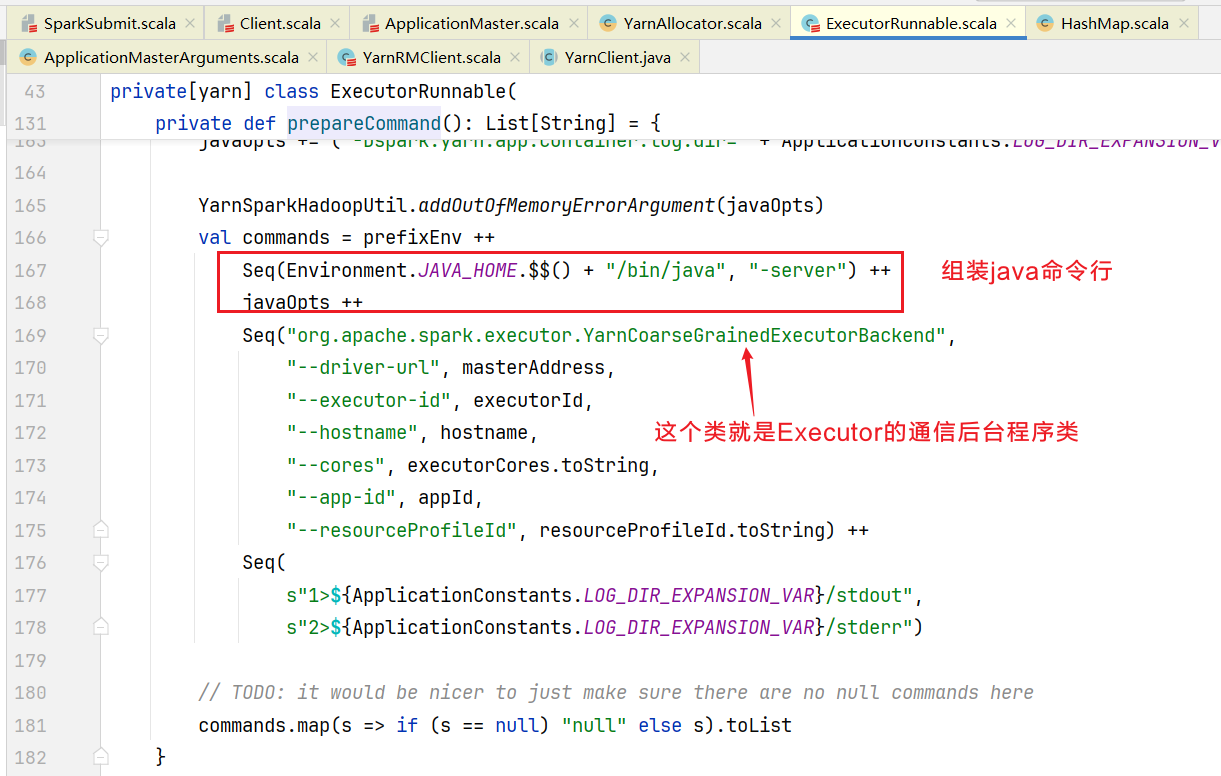
查看YarnCoarseGrainedExecutorBackend的main()方法
def main(args: Array[String]): Unit = {
// createFn就是YarnCoarseGrainedExecutorBackend的对象实例创建函数
val createFn: (RpcEnv, CoarseGrainedExecutorBackend.Arguments, SparkEnv, ResourceProfile) =>
CoarseGrainedExecutorBackend = { case (rpcEnv, arguments, env, resourceProfile) =>
new YarnCoarseGrainedExecutorBackend(rpcEnv, arguments.driverUrl, arguments.executorId,
arguments.bindAddress, arguments.hostname, arguments.cores,
env, arguments.resourcesFileOpt, resourceProfile)
}
val backendArgs = CoarseGrainedExecutorBackend.parseArguments(args,
this.getClass.getCanonicalName.stripSuffix("$"))
// 执行run方法
CoarseGrainedExecutorBackend.run(backendArgs, createFn)
System.exit(0)
}进入CoarseGrainedExecutorBackend的run()方法
def run(
arguments: Arguments,
backendCreateFn: (RpcEnv, Arguments, SparkEnv, ResourceProfile) =>
CoarseGrainedExecutorBackend): Unit = {
Utils.initDaemon(log)
SparkHadoopUtil.get.runAsSparkUser { () =>
// Debug code
Utils.checkHost(arguments.hostname)
// Bootstrap to fetch the driver's Spark properties.
val executorConf = new SparkConf
// 从通信环境中创建fetcher, 使用fetcher得到driver对象
val fetcher = RpcEnv.create(
"driverPropsFetcher",
arguments.bindAddress,
arguments.hostname,
-1,
executorConf,
new SecurityManager(executorConf),
numUsableCores = 0,
clientMode = true)
var driver: RpcEndpointRef = null
val nTries = 3
for (i <- 0 until nTries if driver == null) {
try {
// 得到driver
driver = fetcher.setupEndpointRefByURI(arguments.driverUrl)
} catch {
case e: Throwable => if (i == nTries - 1) {
throw e
}
}
}
......
driverConf.set(EXECUTOR_ID, arguments.executorId)
// 创建spark的环境
val env = SparkEnv.createExecutorEnv(driverConf, arguments.executorId, arguments.bindAddress,
arguments.hostname, arguments.cores, cfg.ioEncryptionKey, isLocal = false)
// Set the application attemptId in the BlockStoreClient if available.
val appAttemptId = env.conf.get(APP_ATTEMPT_ID)
appAttemptId.foreach(attemptId =>
env.blockManager.blockStoreClient.setAppAttemptId(attemptId)
)
val backend = backendCreateFn(env.rpcEnv, arguments, env, cfg.resourceProfile)
// 在通信环境中安装一个名叫"Executor"的终端(Endpoint),
// 其中backend就是YarnCoarseGrainedExecutorBackend对象实例
env.rpcEnv.setupEndpoint("Executor", backend)
arguments.workerUrl.foreach { url =>
env.rpcEnv.setupEndpoint("WorkerWatcher",
new WorkerWatcher(env.rpcEnv, url, isChildProcessStopping = backend.stopping))
}
env.rpcEnv.awaitTermination()
}
}那么如何注册安装的呢,进入setupEndpoint()方法,发现是一个抽象方法,查看具体实现类,可见底层通信使用的是Netty框架  打开registerRpcEndpoint(),进入Dispatcher.scala代码中
打开registerRpcEndpoint(),进入Dispatcher.scala代码中 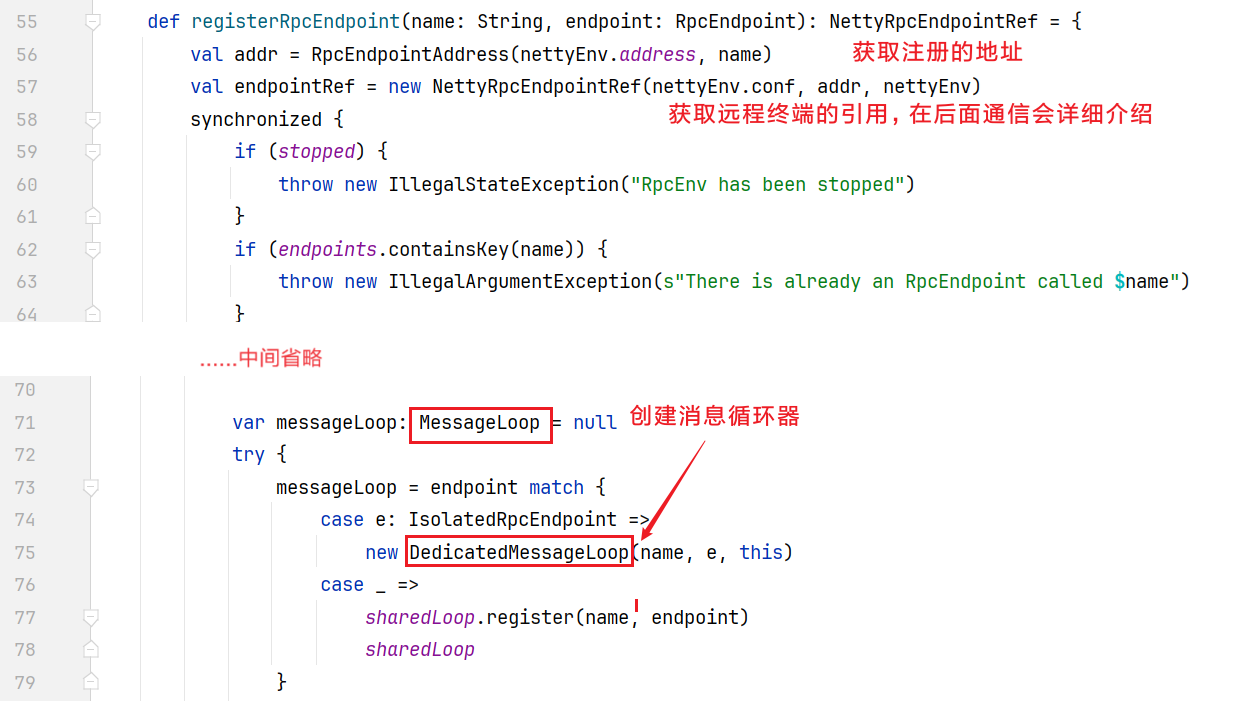 在DedicatedMessageLoop对象中,包含Inbox对象
在DedicatedMessageLoop对象中,包含Inbox对象 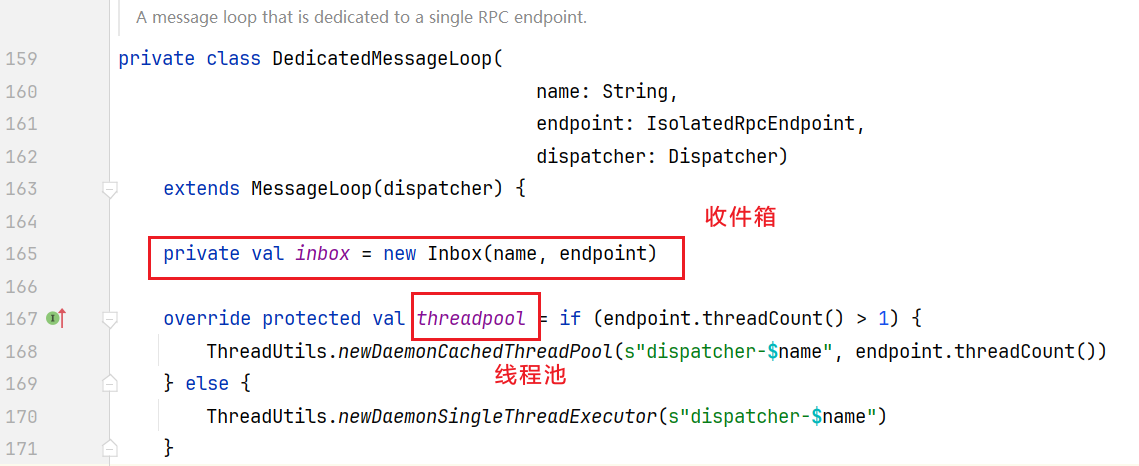 点击进入Inbox对象代码中
点击进入Inbox对象代码中  当前endpoint对象就是CoarseGrainedExecutorBackend类的实例,它是RPCEndPoint的子类,RPCEndPoint本身是有一个生命周期的概念:constructor -> onStart -> receive* -> onStop
当前endpoint对象就是CoarseGrainedExecutorBackend类的实例,它是RPCEndPoint的子类,RPCEndPoint本身是有一个生命周期的概念:constructor -> onStart -> receive* -> onStop  这时CoarseGrainedExecutorBackend收到OnStart就会遵循生命周期去调用onStart方法
这时CoarseGrainedExecutorBackend收到OnStart就会遵循生命周期去调用onStart方法
override def onStart(): Unit = {
...... 代码省略
rpcEnv.asyncSetupEndpointRefByURI(driverUrl).flatMap { ref =>
// This is a very fast action so we can use "ThreadUtils.sameThread"
// 得到Driver
driver = Some(ref)
env.executorBackend = Option(this)
// 向连接Driver,发送内容是注册执行器(Executor)类型消息
ref.ask[Boolean](RegisterExecutor(executorId, self, hostname, cores, extractLogUrls,
extractAttributes, _resources, resourceProfile.id))
}(ThreadUtils.sameThread).onComplete {
// 如果返回注册成功消息,向自己发送已经注册执行器消息
case Success(_) =>
self.send(RegisteredExecutor)
case Failure(e) =>
exitExecutor(1, s"Cannot register with driver: $driverUrl", e, notifyDriver = false)
}(ThreadUtils.sameThread)
}那Driver怎么收到的消息的呢,回到Driver的上下文对象SparkContxt中: 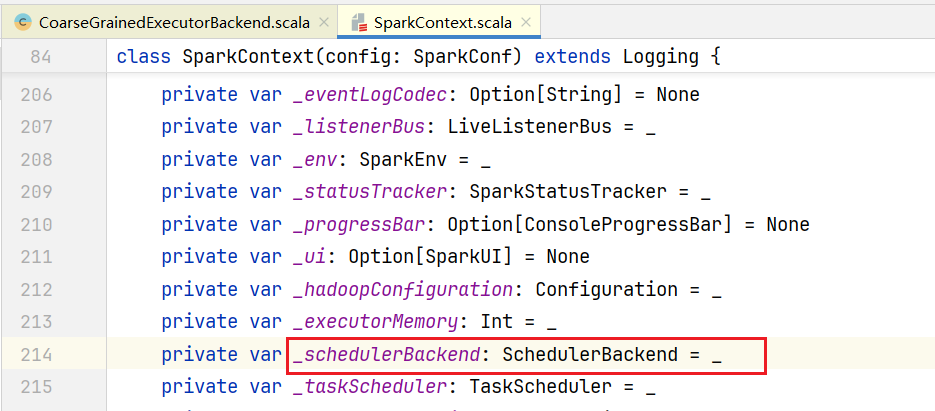 Driver这边也有一个类似的收发消息的终端服务,叫SchedulerBackend类,它是一个抽象类:
Driver这边也有一个类似的收发消息的终端服务,叫SchedulerBackend类,它是一个抽象类:  我们的Spark是部署的不是本地模式,查看CoarseGrainedSchedulerBackend.scala
我们的Spark是部署的不是本地模式,查看CoarseGrainedSchedulerBackend.scala 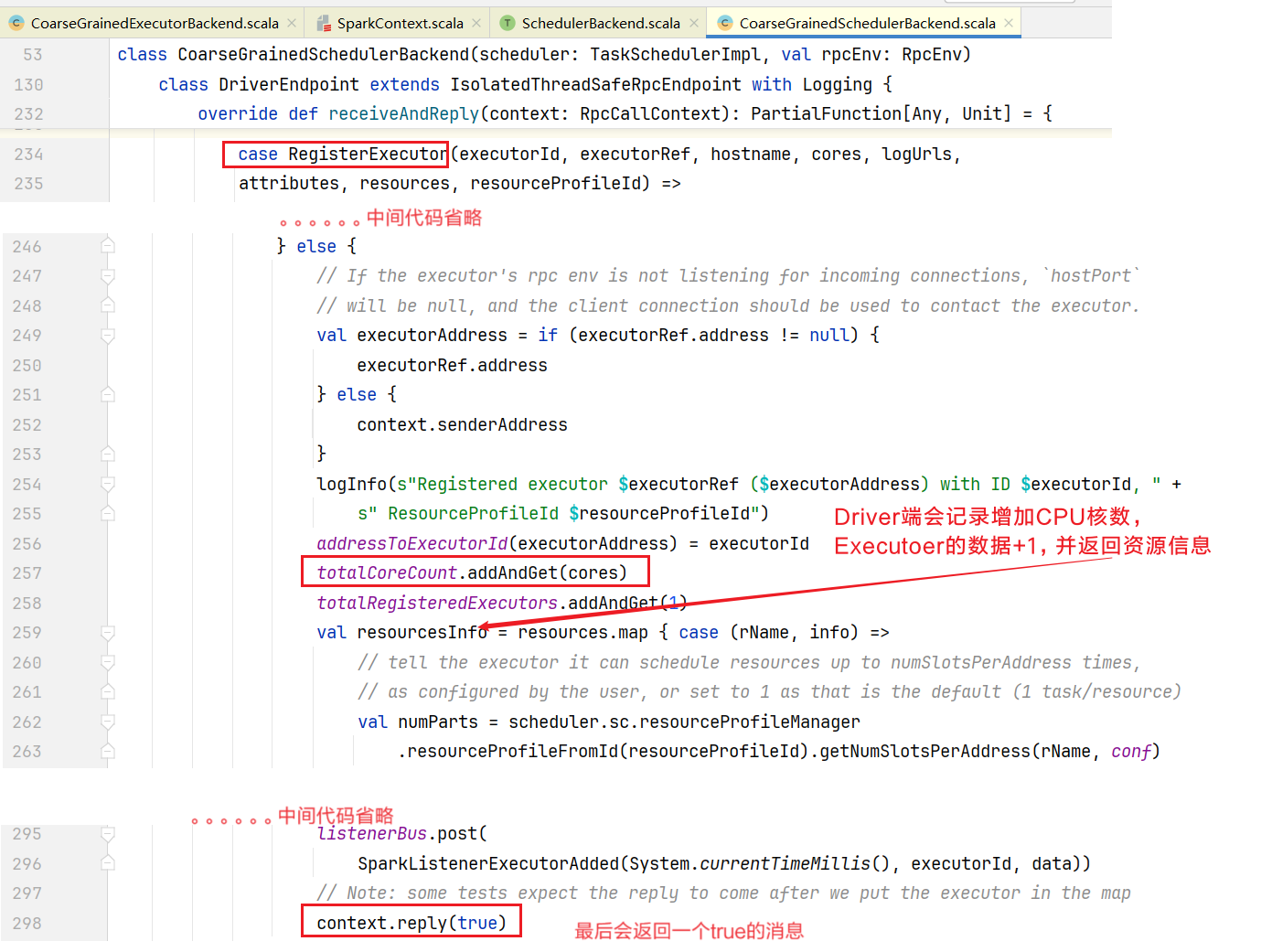
4. 启动Executor计算对象
Executor会往自己身上注册消息,回到CoarseGrainedExecutorBackend.scala中,查看receive方法: 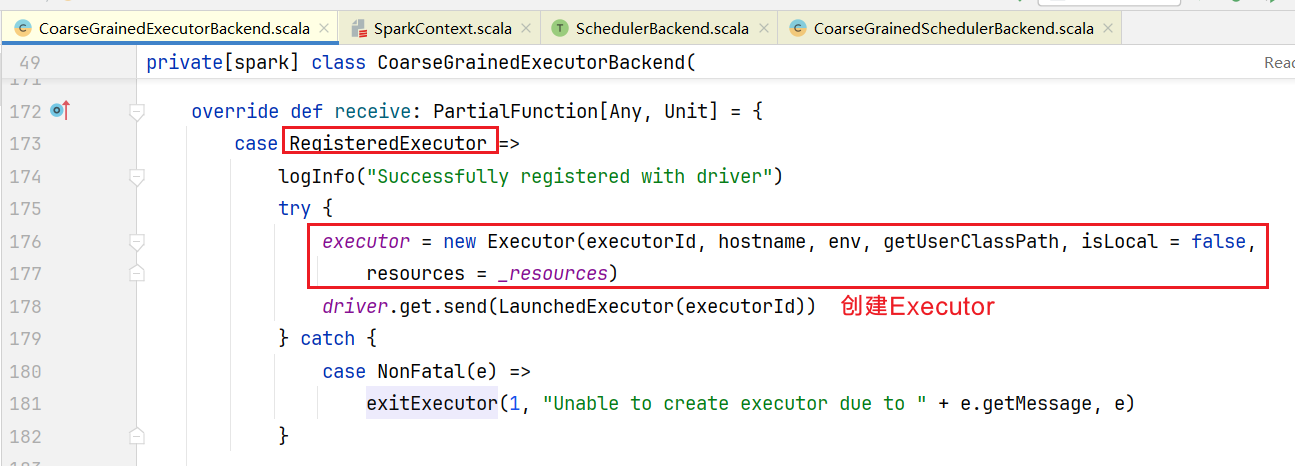 这是创建了真正的Executor计算对象,之前的Excutor只是负责后台通信。然后会向Driver发送LaunchedExecutor类型消息 在Driver端查看收到消息的处理逻辑:
这是创建了真正的Executor计算对象,之前的Excutor只是负责后台通信。然后会向Driver发送LaunchedExecutor类型消息 在Driver端查看收到消息的处理逻辑: 自此Executor节点也被分配启动了。
自此Executor节点也被分配启动了。
